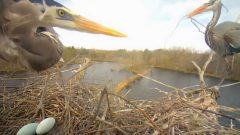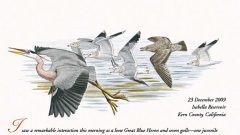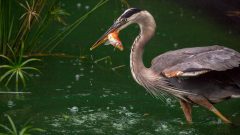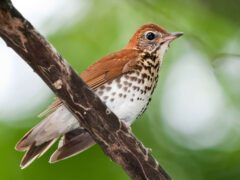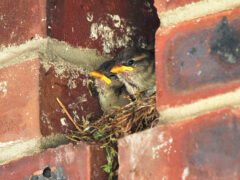Great Blue Heron Similar Species Comparison
Main SpeciesGreat Blue Heron
Adult (Blue form)
Very large and tall, with a long neck. Grayish-blue overall with long orangish-yellow bill and black crown and head plumes.
© Daniel Grossi / Macaulay LibraryOhio, April 09, 2019Immature (Blue form)
Very large and tall, with a long neck. Grayish-blue overall with pale belly, dark streaking on the neck, and brownish feathers mixed throughout. Bill long and dusky colored.
© Ashley Bradford / Macaulay LibraryVirginia, February 18, 2017Adults with Cattle Egret and White Ibis
Often nests in colonies with other species of wading birds. Within colonies, territorial display includes ruffling the long breeding plumes and pointing the head and bill skyward.
© Tom Johnson / Macaulay LibraryFlorida, January 06, 2014Adult (Blue form)
In flight shows black flight feathers contrasting with powdery-blue plumage. Usually flights with neck in, but sometimes outstretched.
© Evan Lipton / Macaulay LibraryMassachusetts, April 24, 2016Adult (White form)
Very large and tall, with a long neck. White form is all white with long yellow bill and dull yellowish legs.
© Alex Lamoreaux / Macaulay LibraryFlorida, May 18, 2012Adult (Blue form)
Stalks prey by wading in shallow water, using daggerlike bill to spear or seize fish and other small animals.
© Eric Liner / Macaulay LibraryNew York, May 01, 2006Adult (Wurdemann's)
Very large and tall, with a long neck. Body powdery-blue with white head, and orangish-yellow bill and legs.
© Michael Todd / Macaulay LibraryFlorida, April 26, 2013Adult (Blue form)
When breeding has dense, shaggy plumes on the back and neck.
© Linda Chittum / Macaulay LibraryVirginia, December 23, 2016Adult (Blue form)
Heavy flight with very slow beats of the very broad wings. Usually flies with neck pulled back and head tucked into shoulders.
© Eric Liner / Macaulay LibraryFlorida, January 20, 2009Adult (Blue form)
Hunts in a variety of shallow wetland habitats.
© Tom Davis / Macaulay LibraryVirginia, May 19, 2016Adult (Blue form)
Nests in colonies of large stick nests high in trees, sometimes not near water.
© Georgia Gerrior / Macaulay LibraryWashington, March 30, 2017Adult (Blue form)
Typically eats aquatic animals but also forages on land, catching mammals.
© Timothy Barksdale / Macaulay LibraryMontana, May 01, 2001Similar SpeciesLittle Blue Heron
Adult
Little Blue Herons are much smaller than Great Blue Herons and they lack the Great Blue's yellow bill and dark crown.
© Etienne Artigau🦩 / Macaulay LibraryFlorida, March 06, 2017Similar SpeciesTricolored Heron
Nonbreeding adult
Tricolored Herons are smaller than Great Blue Herons. They have a darker blue neck than Great Blues and have a unique white line down the front of their neck.
© Ryan Shaw / Macaulay LibraryYucatán, December 26, 2009Similar SpeciesReddish Egret
Nonbreeding adult dark morph
Reddish Egrets are smaller than Great Blue Herons and they have a reddish neck.
© James Rieman / Macaulay LibraryTexas, September 28, 2017Similar SpeciesGreat Egret
Adult
Great Egrets could be confused with white morph Great Blue Herons, but Great Egrets have a thinner bill and darker legs. Great Egrets also lack the Great Blue's head plumes.
© Alex Lamoreaux / Macaulay LibraryPennsylvania, August 17, 2016Similar SpeciesSandhill Crane
Adult
Sandhill Cranes are more uniformly gray, and adult Sandhills have a vivid red crown that Great Blue Herons don't have. In flight, a Sandhill Crane keeps its neck outstretched not tucked in like a Great Blue Heron.
© Curt Morgan / Macaulay LibraryNew York, February 10, 2013Compare with Similar Species
Click on an image to compare
Species in This Family
Herons, Egrets, and Bitterns(Order: Pelecaniformes, Family: Ardeidae)
More to Read
Don't miss a thing! Join our email list
The Cornell Lab will send you updates about birds,
birding, and opportunities to help bird conservation.















